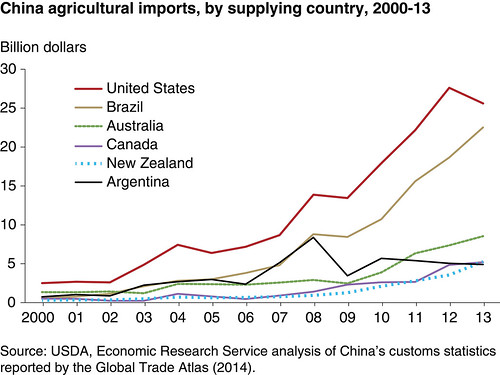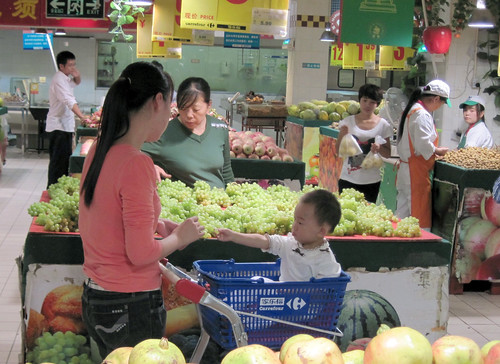
This post is part of the Science Tuesday feature series on the USDA blog. Check back each week as we showcase stories and news from USDA’s rich science and research portfolio.
China is often noted for its dominant export presence in the world market. The ubiquitous “Made in China” label, found on everything from pens to smart phones has made China’s export prowess acutely visible and at times overshadowed the other side of the country’s trade relationship with the world. But in recent years, China’s potential as a significant market has drawn increasing attention.
A new Economic Research Service (ERS) report examines China’s emergence as a major importer of agricultural products over the past decade. Between 2000 and 2013, China’s agricultural imports grew from US$ 10 billion to about US$ 123 billion. The surge in imports has been driven by rising incomes and changing consumer preferences as well as growing demand for industrial raw materials. While bulk commodities such as soybeans and cotton remain predominant in China’s agricultural imports, consumer preferences and increased purchasing power have broadened the scope of these imports. As a result, imports of processed and consumer-oriented products like meats, dairy, wine, and nuts are increasingly showing up in Chinese markets.
The United States has become a particularly important supplier of agricultural products to China. U.S. agricultural sales to China doubled from less than $13 billion in 2008 to nearly $26 billion in 2013, making China the top export destination for U.S. agricultural products in 2013 for the third year in a row. The United States accounts for over half of China’s imports of soybeans and cotton and is currently its leading supplier of consumer-oriented products such as meats. China’s imports of U.S. dairy products and other consumer-oriented products, such as fruits, nuts, and wine, rose from $234 million in 2000 to $2.45 billion in 2014, comprising nearly 12 percent of the total value of U.S. agricultural exports to China that year.
China’s demand for agricultural products is projected to continue growing in the near future. Although soybeans are likely to remain the dominant import commodity, overseas purchases of corn and higher-valued commodities are also anticipated to expand. However, assessing the magnitude of China’s future demand for agricultural imports is difficult for several reasons. China’s slowing growth, accumulated commodity stocks, and recent restrictions imposed by Chinese authorities on some genetically modified varieties of U.S. corn and feed cast uncertainty over the pace of China’s imports.
For more information, see the ERS report China’s Growing Demand for Agricultural Imports.

